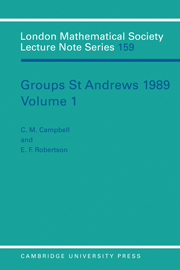Book contents
- Frontmatter
- Contents
- CONTENTS OF VOLUME II
- Preface
- Introduction
- 1 Triply factorized groups
- 2 An introduction to a class of two relator groups
- 3 An infinite family of nonabelian simple table algebras not induced by finite nonabelian simple groups
- 4 Horace Y Mochizuki: In Memoriam
- 5 Bounds on character degrees and class numbers of finite non-abelian simple groups
- 6 Finite presentability and Heisenberg representations
- 7 On nilpotent groups acting on Klein surfaces
- 8 Some algorithms for polycyclic groups
- 9 On the regularity conditions for coloured graphs
- 10 Multiplet classification of highest weight modules over quantum universal enveloping algebras: the Uq(SL(3,C)) example
- 11 Solutions of certain sets of equations over groups
- 12 Generalizing algebraic properties of Fuchsian groups
- 13 A theorem on free products of special abelian groups
- 14 Schur algebras and general linear groups
- 15 On Coxeter's groupsp,q,r
- 16 Integral dimension subgroups
7 - On nilpotent groups acting on Klein surfaces
Published online by Cambridge University Press: 05 April 2013
- Frontmatter
- Contents
- CONTENTS OF VOLUME II
- Preface
- Introduction
- 1 Triply factorized groups
- 2 An introduction to a class of two relator groups
- 3 An infinite family of nonabelian simple table algebras not induced by finite nonabelian simple groups
- 4 Horace Y Mochizuki: In Memoriam
- 5 Bounds on character degrees and class numbers of finite non-abelian simple groups
- 6 Finite presentability and Heisenberg representations
- 7 On nilpotent groups acting on Klein surfaces
- 8 Some algorithms for polycyclic groups
- 9 On the regularity conditions for coloured graphs
- 10 Multiplet classification of highest weight modules over quantum universal enveloping algebras: the Uq(SL(3,C)) example
- 11 Solutions of certain sets of equations over groups
- 12 Generalizing algebraic properties of Fuchsian groups
- 13 A theorem on free products of special abelian groups
- 14 Schur algebras and general linear groups
- 15 On Coxeter's groupsp,q,r
- 16 Integral dimension subgroups
Summary
Introduction
It is well known that a group of automorphisms of a compact Klein surface X of algebraic genus q ≥ 2 has at most 84(q-1) elements [15]. It is also known that this bound is attained as well as it cannot be attained for infinitely many values of q ([8], [9], [10], [17], [18], [29], [31]) but the problem of the classification of those q for which this is so is far away from being solved.
If X has nonempty boundary then the bound in question can be considerably sharpened. It was C L May who started to study groups of automorphisms of such surfaces. Using rather deep analytical machinery he showed in [21] that the bound in this case is 12(q-1) and then in [13], [22], [24], [25], [27], that it is attained for infinitely many values of q (see also [11], [12], [30]). For obvious reasons bordered Klein surfaces of algebraic genus q having a group of automorphisms of order 12(q-1) were named Klein surfaces with maximal symmetry. The problem of classifying such surfaces up to dianalytical equivalence and corresponding groups of automorphisms up to isomorphisms seem to be very difficult. However certain pieces of it seem to be more approachable. Recently for example May [27] has classified topological types of bordered Klein surfaces with maximal symmetry and supersoluble group of automorphisms showing in particular that such a surface of algebraic genus q ≥ 3 must be orientable.
- Type
- Chapter
- Information
- Groups St Andrews 1989 , pp. 65 - 75Publisher: Cambridge University PressPrint publication year: 1991



